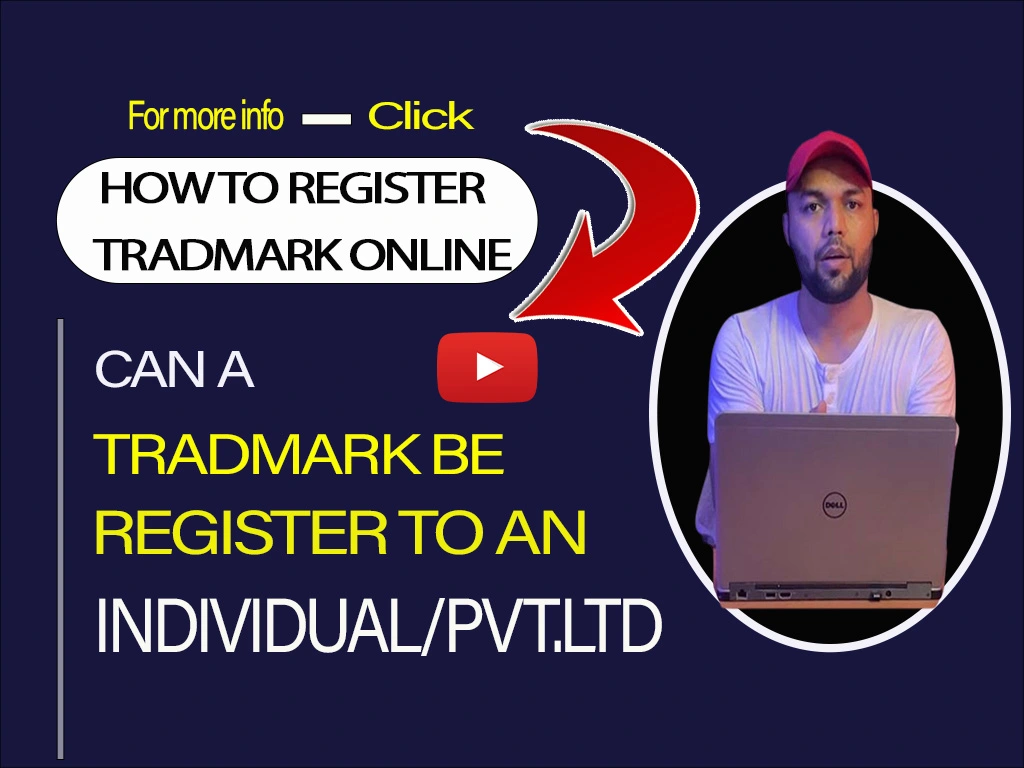Trademark registration in India allows the applicant to use symbols or words to represent a business or the products that are offered by a business to differentiate the goods or services that are offered by them from the competitors. After the trademark is registered in India no other organization can use it as long as it remains in the use of the registered owner.
The “™" symbol can be used with the trademark applicant with the brand once it is registered. Trademark registration is an advantage for the company to protect the brand name it is necessary to apply for trademark registration in India.

Trademark Registration
Trademark registrations are widely used to protect the brand or slogans or stamp words that are unique. Trademark registrations in India can be acquire by individuals or businesses or by non-profit organizations. However, each of the different class of persons or entity have different requirement while filing the trademark application.
AN INDIVIDUAL
An individual who is not doing any business currently can also obtain a trademark application and obtain trademark registration for a symbol or word that is proposed to be used by the applicant in the future.JOINT OWNERS
If in case two people are determining to file a trademark application then the names of both the people must be mentioned on the application.PROPRIETORSHIP FIRMS
While filing a trademark application for a proprietorship firm in India, the full name of the applicant must be mentioned. The business name or the proprietorship is not acceptable.PARTNERSHIP FIRM
When filing a trademark application for the partnership firm the names of all the partners should be mentioned in the application. If there is a minor partner in partnership firm the name of the guardian who is representing the minor should be mentioned.LIMITED LIABILITY PARTNERSHIP
In the case of the Limited Liability Partnership, the application should be in the name of the LLP. An LLP is an incorporated body where it has separate legal identity then its partners. The partners cannot be the applicant as the trademark belongs to the LLP.INDIAN COMPANY
When it comes to a Private Limited Company and the One Person Company or a Public Limited Company making a trademark registration application then the application is to be made in the name of the company. As they all are independent incorporated entities, registration application cannot be applied by the Director. Though it can be signed and submitted by the Director or any other authorized member of the entity.FOREIGN COMPANY
In case a foreign incorporated entity is making a trademark application in India the application is to be made in the corporate name as it is registered under the foreign country. Here in the application one has to mention the nature of the registration, the country, and its law.TRUST OR SOCIETY
In case if the trademark application is made on the behalf of the trust or the society then the name of the managing trustee or the chairman or the secretary that is representing the trust or the society is to be mentioned.
The following are eligible for obtaining trademark registration in India:
Trademarks can be registered under various types. Though there are many trademarks the sole purpose of them is the same that is to enable the consumers to identify the goods and the services that are manufactured by certain manufacturers or service providers.
-
PRODUCT MARK:
A product mark is used on a good or a product rather than a service. A product mark helps in recognizing the origin of the product and helps in maintaining the reputation of the business. Trademark applications that are filed under the trademark class 1-34 could be labeled as product marks as they represent goods. -
SERVICE MARK:
Service Mark is similar to a product mark but the service mark is used to represent a service rather than a product. The main purpose of the service mark is that it helps in discriminating the proprietors from the owners of other similar services. The trademark applications are filed under the trademark class 35-45 that could be labeled as a service mark as they are representing the services. -
COLLECTIVE MARK:
The collective mark notifies the public about the certain distinguishing attributes of the products and the service that is used to represent a collective. A group of individuals can use this mark as they are inclusively protecting the goods and the services. The mark holder can be an association or it can be a public institution or also a Section 8 Company. -
CERTIFICATION MARK:
It is a sign that denotes the product's origin, material, quality, or other precise details which are issued by the proprietor. The main purpose of the certification is to conduct the standard of the product and also guarantee the product to the customers by showing that the product has undergone standard tests to certify quality. Certification marks are usually seen on packed foods, toys, and electronics products. -
SHAPE MARK:
The shape mark is purely used to protect the shape of the product so that the customers find it accessible with a certain manufacturer and prefer to buy the product. The shape of the product can be registered once it is recognized that the product has a remarkable shape. -
PATTERN MARK:
The pattern marks are for those products that have a specified designed pattern that comes out as the distinguishing feature of the product. Patterns that fail to stand out as remarkable marks are rejected. For a pattern mark to be registered it should stick out as unique. -
SOUND MARK:
A sound mark is sounds that can be associated with a product or the service that is derive from a specific supplier. Sound logos are also called audio mnemonics and they appear to be at the beginning or the end of the commercial. Example of the most popular sound mark in India is the tune for IPL.
Here the various types of trademark registrations in India are given as bellow:
The list of documents required to obtain Trademark registration is:
Identity proof of the trademark owner
PAN
Passport
Aadhar Card
Certificate of Incorporation (In case of a Private Limited Company or an LLP)
Udyog Aadhar Registration
Logo if it is applicable and available
Address proof
There are several reasons to get a trademark registration but most are necessary for all the companies and the willing entrepreneurs as it acts as an important asset for the company.
-
Intellectual Property Protection
Trademark registration provides legal protection against the misuse or copy of the company's name or registered logo. The owner of the trademark receives ownership of the trademark which can be legally held in any court. Registering a trademark lets the owner of the trademark receive nationwide ownership of the mark which can be legally upheld in any court. A trademark registration provides an official notice that the trademark is already owned. -
Powerful Deterrent
A trademark owner obtains the right to publicly advertise the brand as a registered trademark that alerts others and prevent the defense of the unintended infringement. Once the trademark is registered the trademark will appear in the search reports that will discourage the other applicants from proceeding with the same or similar mark registration. If you are the first one to register a Trademark then the National Trademark office in New Delhi will refuse the registration to any trademark which seems confusingly to any other such Trademark. -
Legal Remedies
By getting a Trademark registration in India the owner of the trademark can recover up to three time amount damages from the intruder. The owner receives the presumption of being the valid owner of the mark. Registering a trademark gives the owner a right to sue anyone who is exploiting the mark. An unregistered Trademark on the other hand is open to use by anyone.
There are many advantages of getting a trademark registration and utilizing the services. Here are some advantages:
1. Trademark Search
The first step to register your trademark is to that the entrepreneur must search for trademark availability. Doing a Trademark search will provide information about identical or similar Trademarks already filed with the Trademark Registry.
2. Trademark Filing
After completing the Trademark search, the trademark registration application can be filed with the Trademark Registrar. However, the application must be made in a specifically prescribed manner and filed along with the mentioned fees. The application can be made online or in any Trademark Registrar's offices with jurisdiction over the state. The Trademark Registration application must contain the information of Logo or the Trademark, Name and address of the Trademark owner, Trademark used since the date, Description of the goods or services.
3. The Vienna Codification Process
The Vienna Classification or Vienna Codification, established by the Vienna agreement (1973), is an international classification of marks' symbolic elements. Once the Trademark registration application is filed, the Trademark Registrar will apply the Vienna classification to the Trademark based on marks' representative elements. While this work is in progress, the trademark application status usually reflects as "Sent for Vienna Codification."
4. Trademark Examination
After Vienna Codification's completion, the Trademark registration application will get allocate to an officer in the Trademark Registrar's office. The officer will then review the Trademark application for the preciseness and then will issue a Trademark examination report. The officer can accept the Trademark application, allow trademark journal publishing, or object to the Trademark registration process.
If the application is rejected, the applicant can appear before the Trademark officer with his and address the objections. If the officer finds the justification satisfying, the Trademark would be then allowed for Trademark journal publication. If the reasons are not reasonable, the applicant has the right to appeal the officer's decision before the Intellectual Property Appellate Board.
5. Trademark Journal Publication
When the Trademark Registrar accepts the registration application, the proposed Trademark is published in the Trademark journal. This journal is published weekly and contains all the trademarks that the Registrar has received. Also, the public can object to the Trademark Registration if they think that the registration can damage their business in any way. If there are no objections arise within 90 days of the publication, then the mark will be registered within 12 weeks.
If the application faces opposition by a third party, a hearing will be called for by the Trademark Hearing officer. Both the applicant and the opposer have a chance to appear and give their side of justification, respectively. Based on the hearings and the evidence put forward, the Trademark Hearing Officer will determine if the application should be accepted or rejected. However, the decision by the Hearing officer can also be challenged by the escalating officer.
6. Trademark Registration
If there are no objections or oppositions arise, the Trademark manuscript and trademark registration will be prepared and issued. After the Trademark registration Certificate is issued. Trademark is considered to be a registered trademark of the owner, allowing the owner some exclusive rights of the mark. The ® Symbol can now be placed to the logo or the Trademark.

